-

新人教版高中英语必修2Unit 5 Music-Discovering Useful Structures教案一
Step1:自主探究。1.(教材P52)Born(bear) in the USA on 2 January 1970, Whitacre began studying music at the University of Nevada in 1988.2.(教材P52) Moved(move) by this music, he said, “It was like seeing color for the first time.”3.(教材P56)I was very afraid and I felt so alone and discouraged(discourage).4.(教材P58)Encouraged(encourage) by this first performance and the positive reaction of the audience, I have continued to play the piano and enjoy it more every day.Step2:语法要点精析。用法1:过去分词作表语1).过去分词可放在连系动词be, get, feel, remain, seem, look, become等之后作表语,表示主语所处的状态Tom was astonished to see a snake moving across the floor.汤姆很惊讶地看到一条蛇正爬过地板。Finally the baby felt tired of playing with those toys.终于婴儿厌倦了玩那些玩具。注意:1).过去分词作表语时与被动语态的区别过去分词作表语时,强调主语所处的状态;而动词的被动语态表示主语是动作的承受者,强调动作。The library is now closed.(状态)图书馆现在关闭了。The cup was broken by my little sister yesterday.(动作)昨天我妹妹把杯子打碎了。2)感觉类及物动词的现在分词与过去分词作表语的区别过去分词作表语多表示人自身的感受或事物自身的状态,常译作“感到……的”;现在分词多表示事物具有的特性,常译作“令人……的”。
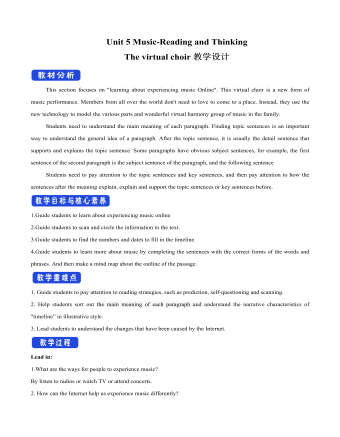
新人教版高中英语必修2Unit 5 Music-Reading and Thinking教案一
This section focuses on "learning about experiencing music Online". This virtual choir is a new form of music performance. Members from all over the world don't need to love to come to a place. Instead, they use the new technology to model the various parts and wonderful virtual harmony group of music in the family. Students need to understand the main meaning of each paragraph. Finding topic sentences is an important way to understand the general idea of a paragraph. After the topic sentence, it is usually the detail sentence that supports and explains the topic sentence. Some paragraphs have obvious subject sentences, for example, the first sentence of the second paragraph is the subject sentence of the paragraph, and the following sentenceStudents need to pay attention to the topic sentences and key sentences, and then pay attention to how the sentences after the meaning explain, explain and support the topic sentences or key sentences before.1.Guide students to learn about experiencing music online2.Guide students to scan and circle the information in the text.3.Guide students to find the numbers and dates to fill in the timeline.4.Guide students to learn more about music by completing the sentences with the correct forms of the words and phrases. And then make a mind map about the outline of the passage.1. Guide students to pay attention to reading strategies, such as prediction, self-questioning and scanning.2. Help students sort out the main meaning of each paragraph and understand the narrative characteristics of "timeline” in illustrative style.3. Lead students to understand the changes that have been caused by the Internet.

新人教版高中英语必修2Unit 5 Music-Reading For Writing教案一
(4)Now we have heard a number of outstanding speeches ... 我们已经聆听了许多精彩的发言……(5)Because we wanted the nations of the world, working together, to deal with ... 因为我们希望全世界各国团结起来去应对……(6)And if we do not act ... 如果我们不采取行动……(7)Now, I share the concerns that have been expressed ... 我也同意对于……表达的担心(8)Let us show the world that by working together we can ... 让我们告诉全世界,通过一起努力我们可以……(9)It is now time for us to ... 是时候我们……(10)And I have always wished that ... 我一直希望……(11)Thank you for letting me share this day with me.感谢你们和我共度这一天。实践演练:假如你是高中生李华,你校将举办一次以“音乐”为主题的演讲比赛,请你按照主题,写下你的演讲稿。注意:词数100左右。First of all, thank you for listening to my speech. My topic is: love music like love yourself.Music is like the air we need to maintain our normal lives around us. You can't imagine how terrible a world without music would be. Movies and TV shows have no music, only dry conversations and scenes; mobile phones only vibrations; streets only noisy crowds; cafes, western restaurants only depressed meals. What a terrible world it is!As a student, I hope we all can enjoy the fun brought by music in our spare time. Instead of just listening to music, we can even make our own music. Let's enjoy the fun of music!Thanks again for your attention!

新人教版高中英语必修3Unit 1 Festivals and Celebrations教学设计一
本板块的活动主题是“谈论节日活动”(Talk about festival activities),主要是从贴近学生日常生活的角度来切入“节日”主题。学生会听到发生在三个国家不同节日场景下的简短对话,对话中的人们正在参与或将要亲历不同的庆祝活动。随着全球化的进程加速,国际交流日益频繁,无论是国人走出国门还是外国友人访问中国,都已成为司空见惯的事情。因此,该板块所选取的三个典型节日场景都是属于跨文化交际语境,不仅每组对话中的人物来自不同的文化背景,对话者的身份和关系也不尽相同。1. Master the new words related to holiday: the lantern, Carnival, costume, dress(sb)up, march, congratulation, congratulate, riddle, ceremony, samba, make - up, after all. 2. To understand the origin of major world festivals and the activities held to celebrate them and the significance of these activities;3. Improve listening comprehension and oral expression of the topic by listening and talking about traditional festivals around the world;4. Improve my understanding of the topic by watching pictures and videos about different traditional festivals around the world;5. Review the common assimilation phenomenon in English phonetics, can distinguish the assimilated phonemes in the natural language flow, and consciously use the assimilation skill in oral expression. Importance:1. Guide students to pay attention to the attitude of the speaker in the process of listening, and identify the relationship between the characters;2. Inspire students to use topic words to describe the festival activities based on their background knowledge. Difficulties:In the process of listening to the correct understanding of the speaker's attitude, accurately identify the relationship between the characters.

新人教版高中英语必修3Unit 2 Morals and virtues教学设计一
(2) students are divided into groups according to the requirements of activity 3. Each student shares a story of personal experience or hearing-witnessing kindness, and then selects the most touching story in the group and shares it with the whole class. Before the students share the story, the teacher can instruct them to use the words and sentence patterns in the box to express. For example, the words in the box can be classified:Time order: first of all, then, after that, later, finally logical relationship :so, however, although, butTeachers can also appropriately add some transitional language to enrich students' expression:Afterwards, afterwards, at last, in the end, eventuallySpatial order: next to, far from, on the left, in front ofOtherwise, nevertheless, as a result, therefore, furthermore, in addition, as well asSummary: in a word, in short, on the whole, to sum up, in briefStep 8 Homework1. Understand the definition of "moral dilemma" and establish a correct moral view;2. Accumulate vocabulary about attitudes and emotions in listening texts and use them to express your own views;3. Complete relevant exercises in the guide plan.1、通过本节内容学习,学生能否理解理解“道德困境”的定义;2、通过本节内容学习,学生能否通过说话人所表达的内容、说话的语气、语调等来判断其态度和情绪;3、通过本节内容学习,学生能否针对具体的道德困境发表自己的看法和见解,能否掌握听力理训练中的听力策略。

新人教版高中英语必修3Unit 3 Diverse Cultures教学设计一
Activity 81.Grasp the main idea of the listening.Listen to the tape and answer the following questions:Who are the two speakers in the listening? What is their relationship?What is the main idea of the first part of the listening? How about the second part?2.Complete the passage.Ask the students to quickly review the summaries of the two listening materials in activity 2. Then play the recording for the second time.Ask them to complete the passage and fill in the blanks.3.Play the recording again and ask the students to use the structure diagram to comb the information structure in the listening.(While listening, take notes. Capture key information quickly and accurately.)Step 8 Talking Activity 91.Focus on the listening text.Listen to the students and listen to the tape. Let them understand the attitudes of Wu Yue and Justin in the conversation.How does Wu Yue feel about Chinese minority cultures?What does Justin think of the Miao and Dong cultures?How do you know that?2.learn functional items that express concerns.Ask students to focus on the expressions listed in activity. 3.And try to analyze the meaning they convey, including praise (Super!).Agree (Exactly!)"(You're kidding.!)Tell me more about it. Tell me more about it.For example, "Yeah Sure." "Definitely!" "Certainly!" "No kidding!" "No wonder!" and so on.4.Ask the students to have conversations in small groups, acting as Jsim and his friends.Justin shares his travels in Guizhou with friends and his thoughts;Justin's friends should give appropriate feedback, express their interest in relevant information, and ask for information when necessary.In order to enrich the dialogue, teachers can expand and supplement the introduction of Miao, dong, Lusheng and Dong Dage.After the group practice, the teacher can choose several groups of students to show, and let the rest of the students listen carefully, after listening to the best performance of the group, and give at least two reasons.
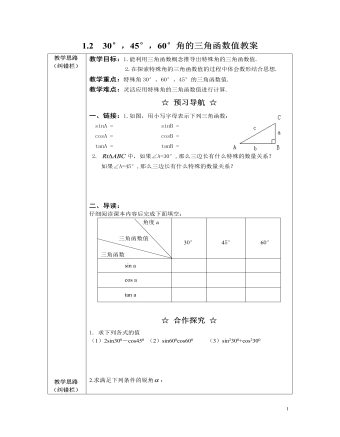
北师大初中九年级数学下册30°,45°,60°角的三角函数值2教案
教学目标:1.能利用三角函数概念推导出特殊角的三角函数值.2.在探索特殊角的三角函数值的过程中体会数形结合思想.教学重点:特殊角30°、60°、45°的三角函数值.教学难点:灵活应用特殊角的三角函数值进行计算.☆ 预习导航 ☆一、链接:1.如图,用小写字母表示下列三角函数:sinA = sinB =cosA = cosB =tanA = tanB =2. 中,如果∠A=30°,那么三边长有什么特殊的数量关系?如果∠A=45°,那么三边长有什么特殊的数量关系?二、导读:仔细阅读课本内容后完成下面填空:
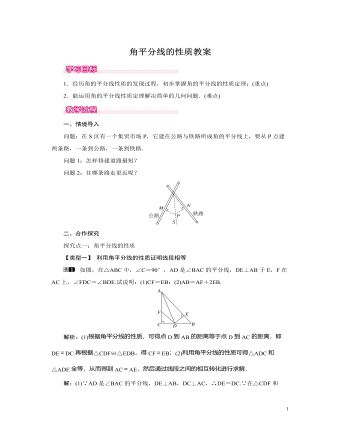
北师大初中七年级数学下册角平分线的性质教案
解析:根据AB∥CD,∠ACD=120°,得出∠CAB=60°.再根据尺规作图得出AM是∠CAB的平分线,即可得出∠MAB的度数.解:∵AB∥CD,∴∠ACD+∠CAB=180°.又∵∠ACD=120°,∴∠CAB=60°.由尺规作图知AM是∠CAB的平分线,∴∠MAB=12∠CAB=30°.方法总结:通过本题要掌握角平分线的作图步骤,根据作图明确AM是∠BAC的角平分线是解题的关键.三、板书设计1.角平分线的性质:角平分线上的点到这个角的两边的距离相等.2.角平分线的作法本节课由于采用了动手操作以及讨论交流等教学方法,从而有效地增强了学生对角以及角平分线的性质的感性认识,提高了学生对新知识的理解与感悟,因而本节课的教学效果较好,学生对所学的新知识掌握较好,达到了教学的目的.不足之处是少数学生在性质的运用上还存在问题,需要在今后的教学与作业中进一步的加强巩固和训练
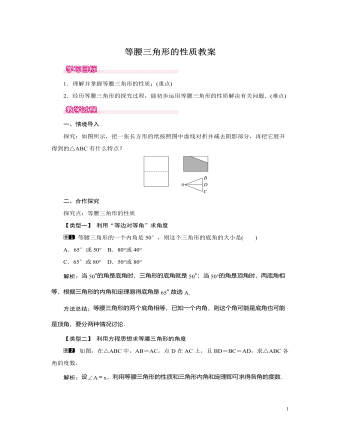
北师大初中七年级数学下册等腰三角形的性质教案
方法总结:在等腰三角形有关计算或证明中,会遇到一些添加辅助线的问题,其顶角平分线、底边上的高、底边上的中线是常见的辅助线.三、板书设计1.等腰三角形的性质:等腰三角形是轴对称图形;等腰三角形顶角的平分线、底边上的中线、底边上的高重合(也称“三线合一”),它们所在的直线都是等腰三角形的对称轴;等腰三角形的两个底角相等.2.运用等腰三角性质解题的一般思想方法:方程思想、整体思想和转化思想.本节课由于采用了直观操作以及讨论交流等教学方法,从而有效地增强了学生的感性认识,提高了学生对新知识的理解与感悟,因而本节课的教学效果较好,学生对所学的新知识掌握较好,达到了教学的目的.不足之处是少数学生对等腰三角形的“三线合一”性质理解不透彻,还需要在今后的教学和作业中进一步巩固和提高
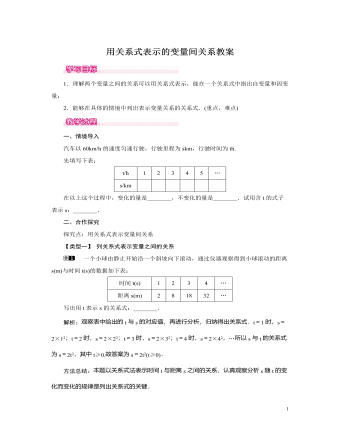
北师大初中七年级数学下册用关系式表示的变量间关系教案
方法总结:观察表中的数据,发现其中的变化规律,然后根据其增减趋势写出自变量与因变量之间的关系式.三、板书设计1.用关系式表示变量间关系2.表格和关系式的区别与联系:表格能直接得到某些具体的对应值,但不能直接反映变量的整体变化情况;用关系式表示变量之间的关系简单明了,便于计算分析,能方便求出自变量为任意一个值时,相对应的因变量的值,但是需计算.本节课的教学内容是变量间关系的另一种表示方法,这种表示方法学生才接触到,学生感觉有点难.这节课的重点是让学生掌握用关系式与表格表示变量间的关系,难点是理解这两种表示方法的优缺点.就此问题,通过让学生对几个例子比较、讨论、总结、归纳两种方法的优点来解决,这样学生就能很好地区分这两种表示方法,并能对不同的问题选择恰当的方法
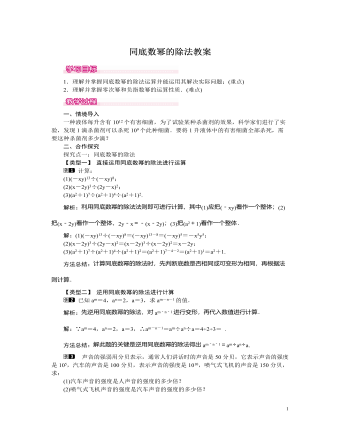
北师大初中七年级数学下册同底数幂的除法教案
【类型四】 含整数指数幂、零指数幂与绝对值的混合运算计算:-22+(-12)-2+(2015-π)0-|2-π2|.解析:分别根据有理数的乘方、零指数幂、负整数指数幂及绝对值的性质计算出各数,再根据实数的运算法则进行计算.解:-22+(-12)-2+(2015-π)0-|2-π2|=-4+4+1-2+π2=π2-1.方法总结:熟练掌握有理数的乘方、零指数幂、负整数指数幂及绝对值的性质是解答此题的关键.三、板书设计1.同底数幂的除法法则:同底数幂相除,底数不变,指数相减.2.零次幂:任何一个不等于零的数的零次幂都等于1.即a0=1(a≠0).3.负整数次幂:任何一个不等于零的数的-p(p是正整数)次幂,等于这个数p次幂的倒数.即a-p=1ap(a≠0,p是正整数).从计算具体问题中的同底数幂的除法,逐步归纳出同底数幂除法的一般性质.教学时要多举几个例子,让学生从中总结出规律,体验自主探究的乐趣和数学学习的魅力,为以后的学习奠定基础
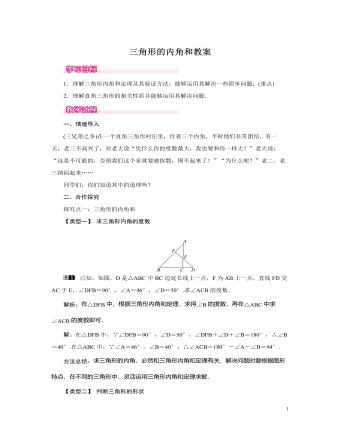
北师大初中七年级数学下册三角形的内角和教案
解:∵CE⊥AF,∴∠DEF=90°,∴∠EDF=90°-∠F=90°-40°=50°.由三角形的内角和定理得∠C+∠DBC+∠CDB=∠F+∠DEF+∠EDF,又∵∠CDB=∠EDF,∴30°+∠DBC=40°+90°,∴∠DBC=100°.方法总结:本题主要利用了“直角三角形两锐角互余”的性质和三角形的内角和定理,熟记性质并准确识图是解题的关键.三、板书设计1.三角形的内角和定理:三角形的内角和等于180°.2.三角形内角和定理的证明3.直角三角形的性质:直角三角形两锐角互余.本节课通过一段对话设置疑问,巧设悬念,激发起学生获取知识的求知欲,充分调动学生学习的积极性,使学生由被动接受知识转为主动学习,从而提高学习效率.然后让学生自主探究,在教学过程中充分发挥学生的主动性,让学生提出猜想.在教学中,教师通过必要的提示指明学生思考问题的方向,在学生提出验证三角形内角和的不同方法时,教师注意让学生上台演示自己的操作过程和说明自己的想法,这样有助于学生接受三角形的内角和是180°这一结论
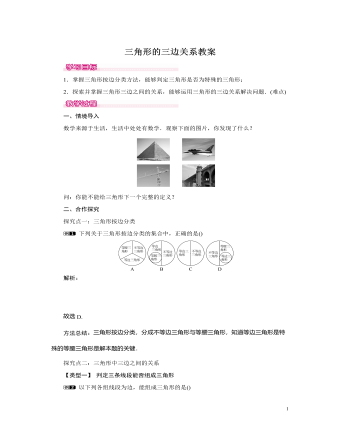
北师大初中七年级数学下册三角形的三边关系教案
方法总结:绝对值的化简首先要判断绝对值符号里面的式子的正负,然后根据绝对值的性质将绝对值的符号去掉,最后进行化简.此类问题就是根据三角形的三边关系,判断绝对值符号里面式子的正负,然后进行化简.三、板书设计1.三角形按边分类:有两边相等的三角形叫做等腰三角形,三边都相等的三角形是等边三角形,三边互不相等的三角形是不等边三角形.2.三角形中三边之间的关系:三角形任意两边之和大于第三边,三角形任意两边之差小于第三边.本节课让学生经历一个探究解决问题的过程,抓住“任意的三条线段能不能围成一个三角形”引发学生探究的欲望,围绕这个问题让学生自己动手操作,发现有的能围成,有的不能围成,由学生自己找出原因,为什么能?为什么不能?初步感知三条边之间的关系,重点研究“能围成三角形的三条边之间到底有什么关系”.通过观察、验证、再操作,最终发现三角形任意两边之和大于第三边这一结论.这样教学符合学生的认知特点,既增加了学习兴趣,又增强了学生的动手能力

北师大初中七年级数学下册用表格表示的变量间关系教案
解:(1)电动车的月产量y为随着时间x的变化而变化,有一个时间x就有唯一一个y与之对应,月产量y是时间x的因变量;(2)6月份产量最高,1月份产量最低;(3)6月份和1月份相差最大,在1月份加紧生产,实现产量的增值.方法总结:观察因变量随自变量变化而变化的趋势,实质是观察自变量增大时,因变量是随之增大还是减小.三、板书设计1.常量与变量:在一个变化过程中,数值发生变化的量为变量,数值始终不变的量称之为常量.2.用表格表示数量间的关系:借助表格表示因变量随自变量的变化而变化的情况.自变量和因变量是用来描述我们所熟悉的变化的事物以及自然界中出现的一些变化现象的两个重要的量,对于我们所熟悉的变化,在用了这两个量的描述之后更加鲜明.本节是学好本章的基础,教学中立足于学生的认知基础,激发学生的认知冲突,提升学生的认知水平,使学生在原有的知识基础上迅速迁移到新知上来
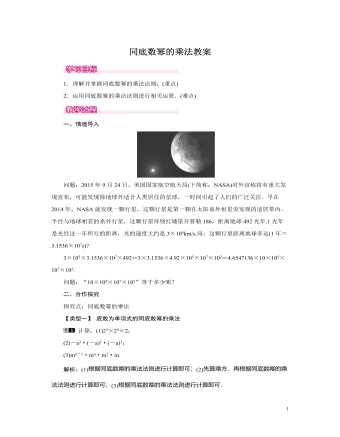
北师大初中七年级数学下册同底数幂的乘法教案
问题:2015年9月24日,美国国家航空航天局(下简称:NASA)对外宣称将有重大发现宣布,可能发现除地球外适合人类居住的星球,一时间引起了人们的广泛关注.早在2014年,NASA就发现一颗行星,这颗行星是第一颗在太阳系外恒星旁发现的适居带内、半径与地球相若的系外行星,这颗行星环绕红矮星开普勒186,距离地球492光年.1光年是光经过一年所行的距离,光的速度大约是3×105km/s.问:这颗行星距离地球多远(1年=3.1536×107s)?3×105×3.1536×107×492=3×3.1536×4.92×105×107×102=4.6547136×10×105×107×102.问题:“10×105×107×102”等于多少呢?二、合作探究探究点:同底数幂的乘法【类型一】 底数为单项式的同底数幂的乘法计算:(1)23×24×2;(2)-a3·(-a)2·(-a)3;(3)mn+1·mn·m2·m.解析:(1)根据同底数幂的乘法法则进行计算即可;(2)先算乘方,再根据同底数幂的乘法法则进行计算即可;(3)根据同底数幂的乘法法则进行计算即可.
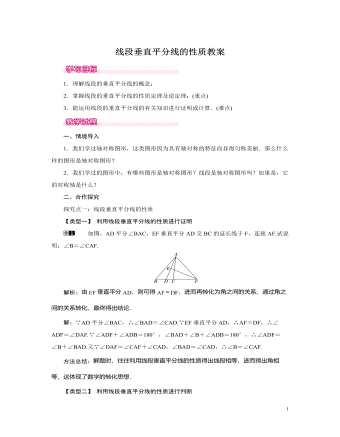
北师大初中七年级数学下册线段垂直平分线的性质教案
解析:(1)根据AD∥BC可知∠ADC=∠ECF,再根据E是CD的中点可求出△ADE≌△FCE,根据全等三角形的性质即可解答;(2)根据线段垂直平分线的性质判断出AB=BF即可解答.解:(1)∵AD∥BC,∴∠ADC=∠ECF.∵E是CD的中点,∴DE=EC.又∵∠AED=∠CEF,∴△ADE≌△FCE,∴FC=AD;(2)∵△ADE≌△FCE,∴AE=EF,AD=CF.又∵BE⊥AE,∴BE是线段AF的垂直平分线,∴AB=BF=BC+CF.∵AD=CF,∴AB=BC+AD.方法总结:此题主要考查线段的垂直平分线的性质等几何知识.线段垂直平分线上的点到线段两个端点的距离相等,利用它可以证明线段相等.探究点二:线段垂直平分线的作图如图,某地由于居民增多,要在公路l边增加一个公共汽车站,A,B是路边两个新建小区,这个公共汽车站C建在什么位置,能使两个小区到车站的路程一样长(要求:尺规作图,保留作图痕迹,不写画法)?
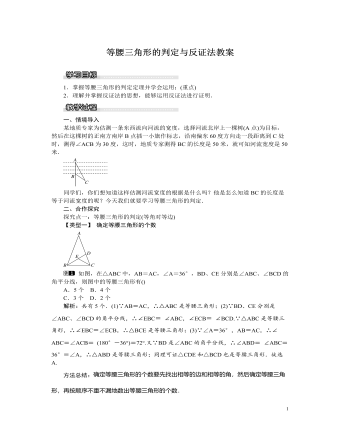
北师大初中八年级数学下册等腰三角形的判定与反证法教案
方法总结:本题结合三角形内角和定理考查反证法,解此题关键要懂得反证法的意义及步骤.反证法的步骤是:(1)假设结论不成立;(2)从假设出发推出矛盾;(3)假设不成立,则结论成立.在假设结论不成立时要注意考虑结论的反面所有可能的情况.如果只有一种,那么否定一种就可以了,如果有多种情况,则必须一一否定.三、板书设计1.等腰三角形的判定定理:有两个角相等的三角形是等腰三角形(等角对等边).2.反证法(1)假设结论不成立;(2)从假设出发推出矛盾;(3)假设不成立,则结论成立.解决几何证明题时,应结合图形,联想我们已学过的定义、公理、定理等知识,寻找结论成立所需要的条件.要特别注意的是,不要遗漏题目中的已知条件.解题时学会分析,可以采用执果索因(从结论出发,探寻结论成立所需的条件)的方法.
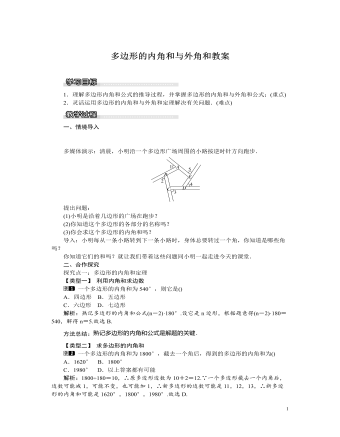
北师大初中八年级数学下册多边形的内角和与外角和教案
方法总结:解题的关键是由题意列出不等式求出这个少算的内角的取值范围.探究点二:多边形的外角和定理【类型一】 已知各相等外角的度数,求多边形的边数正多边形的一个外角等于36°,则该多边形是正()A.八边形 B.九边形C.十边形 D.十一边形解析:正多边形的边数为360°÷36°=10,则这个多边形是正十边形.故选C.方法总结:如果已知正多边形的一个外角,求边数可直接利用外角和除以这个角即可.【类型二】 多边形内角和与外角和的综合运用一个多边形的内角和与外角和的和为540°,则它是()A.五边形 B.四边形C.三角形 D.不能确定解析:设这个多边形的边数为n,则依题意可得(n-2)×180°+360°=540°,解得n=3,∴这个多边形是三角形.故选C.方法总结:熟练掌握多边形的内角和定理及外角和定理,解题的关键是由已知等量关系列出方程从而解决问题.
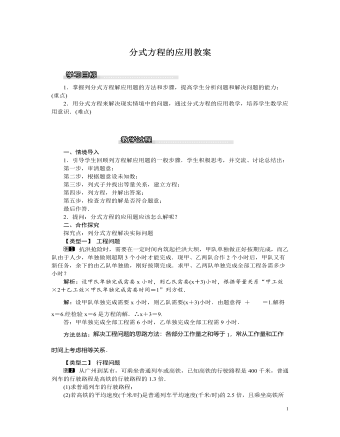
北师大初中八年级数学下册分式方程的应用教案
解:(1)设第一次购买的单价为x元,则第二次的单价为1.1x元,根据题意得14521.1x-1200x=20,解得x=6.经检验,x=6是原方程的解.(2)第一次购买水果1200÷6=200(千克).第二次购买水果200+20=220(千克).第一次赚钱为200×(8-6)=400(元),第二次赚钱为100×(9-6.6)+120×(9×0.5-6.6)=-12(元).所以两次共赚钱400-12=388(元).答:第一次水果的进价为每千克6元;该老板两次卖水果总体上是赚钱了,共赚了388元.方法总结:本题具有一定的综合性,应该把问题分解成购买水果和卖水果两部分分别考虑,掌握这次活动的流程.三、板书设计列分式方程解应用题的一般步骤是:第一步,审清题意;第二步,根据题意设未知数;第三步,根据题目中的数量关系列出式子,并找准等量关系,列出方程;第四步,解方程,并验根,还要看方程的解是否符合题意;最后作答.
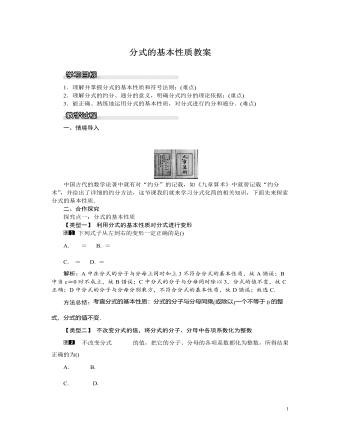
北师大初中八年级数学下册分式的基本性质教案
【类型二】 分式的约分约分:(1)-5a5bc325a3bc4;(2)x2-2xyx3-4x2y+4xy2.解析:先找分子、分母的公因式,然后根据分式的基本性质把公因式约去.解:(1)-5a5bc325a3bc4=5a3bc3(-a2)5a3bc3·5c=-a25c;(2)x2-2xyx3-4x2y+4xy2=x(x-2y)x(x-2y)2=1x-2y.方法总结:约分的步骤;(1)找公因式.当分子、分母是多项式时应先分解因式;(2)约去分子、分母的公因式.三、板书设计1.分式的基本性质:分式的分子与分母都乘以(或除以)同一个不为零的整式,分式的值不变.2.符号法则:分式的分子、分母及分式本身,任意改变其中两个符号,分式的值不变;若只改变其中一个符号或三个全变号,则分式的值变成原分式值的相反数.本节课的流程比较顺畅,先探究分式的基本性质,然后顺势探究分式变号法则.在每个活动中,都设计了具有启发性的问题,对各个知识点进行分析、归纳总结、例题示范、方法指导和变式练习.一步一步的来完成既定目标.整个学习过程轻松、愉快、和谐、高效.

